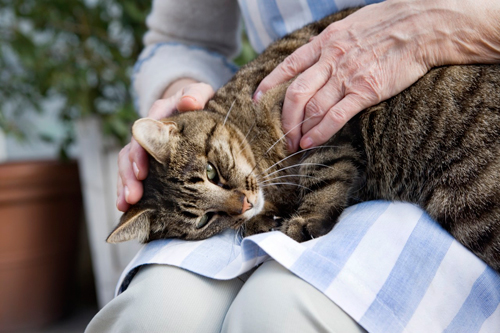For thousands of years, people have had strong connections to animals and often believe they had special powers. Ancient Egyptians worshipped cats, while some Native American tribes thought eagles could deliver prayers to God. Such beliefs have been relegated to folklore, but animals have proven their talents and value to humans in many ways. Gorillas and chimpanzees can learn a form of language, and also demonstrate what seems to be genuine affection for humans. Seeing-eye dogs help their blind owners steer a safe path through daily life. These talented guides will even disobey a direct command from their owners if they fear it will present a risk of injury.
Modern science continues to reveal new insights about what animals feel and how they can serve as “therapists” for people with certain conditions. As a result, interactions between humans and animals have become more common in medical practice. Species of dog, cat, bird, fish, and horse are currently used for animal-assisted therapy in many settings. The value of this therapy has been documented in schools, hospitals, nursing homes, hospice care, drug-abuse treatment, physical therapy, and other programs.
A review of 69 studies published in Frontiers of Psychology revealed a wide range of health benefits resulting from human-animal interaction, including:
- Improved social attention, behavior, interpersonal interaction, and mood
- Reduction of stress as measured by cortisol, heart rate, and blood pressure
- Reduction of self-reported fear and anxiety
- Improved mental and physical health, especially cardiovascular health
Canine Caregivers Help Children with Autism Disorders
Because of the long history of communication between dogs and humans, man’s best friend has played a major role in animal-assisted therapy. Canines are especially beneficial to children with disorders involving sensory overload or detachment from their environment, such as autism. One reason why these interactions may be beneficial for autistic children is that the dogs provide definitive stimuli. Their distinctive bark, specific odor, and striking appearance can help trigger a response in those with low sensory and emotional levels of arousal. The presence of a friendly dog in a therapeutic session can promote more socially appropriate behaviors, as well as improve attention and use of language in those with autism.
At Educated Canines Assisting with Disabilities in Dobbs Ferry, New York, 15-day training sessions with dogs have been shown to dramatically improve patients’ confidence and emotional stability. In this program, therapy dogs work with patients, who then bring the dogs home as pets. The animals are trained to calm patients who start to show stress from sensory overload, as well as to respond positively when patients provide comforting gestures to them. Other programs have shown that allowing troubled children to care for animals, ranging from rabbits and sheep to wounded birds, helps them de-stress and feel more comfortable with themselves.
Paws Against Pain: Dogs and Cats Soothe Patients and the Elderly
Just being with an animal may provide some relief for people who suffer from chronic pain. A study at a pain management clinic compared patients who spent time in the waiting room with a therapy dog to those who waited without dogs. Meaningful pain relief was reported in 23% of patients who were paired with a pooch, but in only 4% of those weren’t.
Contact with animals can also reduce stress, depression, and feelings of loneliness in the elderly in institutional settings. Some of these special companions also demonstrate an acute sensitivity to the onset of death, when comfort is needed most. A famous example is Otto, a tortoiseshell and white cat in a Rhode Island nursing home who curls up with patients on their beds to provide solace during their last four hours of life. Otto has been correct in his assessment in more than 50 cases at the home. This sensitivity may be due to detecting a scent associated with dying, or some other biological indicator.
Some animals have other sensitivities to human behavior yet to be adequately explained by scientific inquiry. Alice Peck, one of our Rewire Me editors, has a cat and dog that seem able to sense when her husband gets off the subway or bus on his way home from work—no matter what time of day it is.
Medical Findings Confirm Health Benefits of Animal-Human Interaction
Studies have shown that contact with a friendly dog can reduce blood pressure, even when the dog is a stranger. Research conducted by the Institute of HeartMath (IHM) digs a little deeper. IHM Director Dr. Rollin McCraty has investigated the energetic bond between humans and pets, including the one between his teenaged son Josh and the family dog, Mabel. He measured the heart patterns of both boy and dog as his son “intentionally radiated love” toward the family pet. “His [Josh’s] heart rhythms became more coherent, and this change appears to have influenced Mabel’s heart rhythms, which then also become more coherent,” according to Dr. McCraty. (“Coherence” is an ordered, rhythmic state of heart pattern that tends to be more associated with positive emotions. IHM research has shown that a higher level of coherence is associated with greater health and resiliency for dealing with challenges.) Furthermore, Mabel’s heart activity became more erratic when Josh left the room—an indication of separation anxiety.
Levels of cortisol—which go up when we are stressed—go down in humans after contact with friendly dogs. Interactions with animals can also increase a person’s level of oxytocin, a hormone that contributes to positive feelings and overall health. Oxytocin is produced in the hypothalamus and released into the bloodstream in response to sensory stimulation. It promotes social interaction and elevates feelings of trust and empathy, while also enhancing one’s self-image. Pet owners experience longer-lasting benefits from oxytocin effects compared to those having less frequent animal contact.
Can Animals Mourn? The Case of the Somber Siamese
It’s not easy to prove that cats mourn the loss of their human companions, but I witnessed an event while growing up that makes me believe it might be so. My grandmother had a special relationship with an exotic-looking Siamese cat named Malu. Years of inbreeding had left Malu a legacy of crossed eyes, but she was otherwise quite striking with her blue eyes, black face and tail, and sleek tan fur. By day, Malu would sit almost continuously on the lap of my grandmother as she read and stroked her. By night, Malu would curl up next to her in bed, her head on the pillow. When my grandmother died, Malu went into what seemed like a state of shock. She wandered around the house in slow motion, often stopping in the middle of a room and staring blankly. But the most curious thing was what happened to her black face: It turned completely gray. It was as if she had used up eight of her nine lives in the blink of a blue eye. About a month later, Malu’s face returned to black. The mourning period was over.
Have you had encounters with animals that convinced you they have extraordinary capabilities? Put them in the Comments section below!
Find Out More
- Karen Allen et al., “Cardiovascular Reactivity and the Presence of Pets, Friends, and Spouses: The Truth About Cats and Dogs,” Psychosomatic Medicine
- “People and Pets—Healing Each Other,” Institute of HeartMath
- Andrea Beetz et al., “Psychosocial and Psychophysiological Effects of Human-Animal Interactions: The Possible Role of Oxytocin,” Frontiers in Psychology




1 Comment
Barry Chudakov
Ed,
Excellent article. Two other books RewireMe readers may find valuable: When Elephants Weep, The Emotional Lives of Animals by Jeffrey Moussaieff Masson and Susan McCarthy; Adam’s Task, Calling Animals by Name by Vicki Hearne.